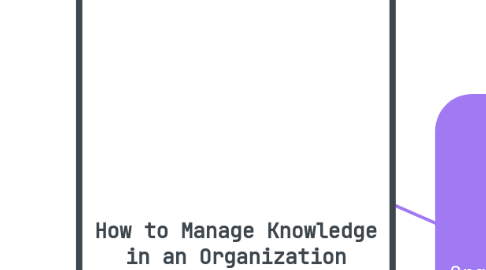
1. Web based Knowledge Management Systems
1.1. Benefits of web based Knowledge Management
1.1.1. Semantic Web (Web 3.0) can energize and enhance KM
1.1.2. Range of users
1.1.3. Location-independent
1.1.4. Easy to find, use and share the information
1.2. The Purpose of web based Knowledge Management Systems
1.2.1. Improve employees professionalism
1.2.2. Encourage coordination with other organizations and users
1.2.3. Promote knowledge innovation
1.2.4. Create more web accessible databases for users
1.2.5. Find out future requirements
1.2.6. Create knowledge based society
1.3. Steps in web based Knowledge Management
1.3.1. Knowledge Capture
1.3.2. Knowledge Organization
1.3.3. Knowledge Filtration
1.3.4. Knowledge Preservation
1.4. Requirements of a web based Knowledge Management System
1.4.1. Web Server
1.4.2. Programming language and database
1.4.3. Network
1.4.4. Knowledge Management Portal
1.4.5. Web based discussion board or forum
1.4.6. Blogs
1.4.7. Wikis
1.4.8. Expert Systems
1.4.9. Mind Maps
1.4.10. Electronic Management System
1.4.11. Podcasts
2. Knowledge Management is a process of:
2.1. Knowledge Creation
2.1.1. Development of new and useful ideas and solutions
2.1.2. Knowledge Creation is an emergent process of:
2.1.2.1. Motivation
2.1.2.2. Experimentation
2.1.2.3. Inspiration
2.1.2.4. Chance
2.2. Knowledge Validation
2.2.1. Knowledge Validation is a process of:
2.2.1.1. Continually Monitoring,
2.2.1.2. Testing,
2.2.1.3. and Refining of knowledge
2.2.2. Conversion the parts of knowledge into
2.2.2.1. Information
2.2.2.2. Data
2.3. Knowledge Presentation
2.3.1. The ways knowledge is displayed to the organizational members.
2.3.1.1. Knowledge is distributed and scattered in different locations
2.3.1.2. Knowledge is embedded into different artifacts and procedures
2.3.1.3. Knowledge is stored into different mediums
2.3.1.3.1. Print
2.3.1.3.2. Disks
2.3.1.3.3. Optical Media
2.3.1.3.4. Clouds
2.4. Knowledge Distribution
2.4.1. Knowledge needs to be distributed and shared throughout the organization, before it can be exploited at the organizational level.
2.5. Knowledge Application
2.5.1. Organizational knowledge needs to be employed into a company's products, processes, and services.
2.5.1.1. Ways of employing knowledge resources:
2.5.1.1.1. Repackaging available knowledge in a different context
2.5.1.1.2. Raise the internal measurement standard
2.5.1.1.3. Train and motivate its people to think creatively
2.5.1.1.4. Use their understanding in the company's products, processes or services
2.5.2. Knowledge Application = making knowledge more active and relevant for the firm in creating values.
3. Definition of KM
3.1. "Knowledge Management is the process of capturing, distributing, and effectively using knowledge."
3.1.1. The classic definition of KM by Tom Davenport (1994).
3.2. "Knowledge management is a discipline that promotes an integrated approach to identifying, capturing, evaluating, retrieving, and sharing all of an enterprise's information assets. These assets may include databases, documents, policies, procedures, and previously un-captured expertise and experience in individual workers."
3.2.1. The most cited definition by Bryant Duhon (1998) from the Gartner Group.
3.3. See also
3.3.1. The Key Components of Knowledge Management
4. Organizational Knowledge is formed through unique patterns of interactions between:
4.1. Technologies
4.1.1. IT can turn data into information
4.1.1.1. People interpret information and turn it into knowledge
4.1.1.2. Organizations need to shape and redefine interactions between its people, technology and techniques.
4.1.1.2.1. An organization is a system of
4.1.1.2.2. Personal experience
4.1.1.2.3. Social relations
4.1.1.2.4. Technologies
4.1.1.3. IT can capture, store, and distribute information
4.1.1.3.1. Limit on information interpretation
4.2. Techniques
4.2.1. The techniques employed by the operators or the users will determine how adroitly the technology is used and how the meanings of information are comprehended.
4.3. People
4.3.1. Knowledge creating cultures
4.3.1.1. Organizations should coach its people to coordinate their interactions.
4.3.1.1.1. To expand the "collective knowledge"
4.3.1.1.2. To develop meaningful interactions between the communities of practice
4.3.1.2. Direct individual knowledge for the organizational purposes
4.3.1.2.1. Develop and nurture an environment of
4.3.1.2.2. Knowledge sharing
4.3.1.2.3. Knowledge transformation
4.3.1.2.4. Knowledge integration
4.3.1.2.5. between its members.
4.3.1.3. Knowledge Management refers to changing corporate culture and business procedures
4.3.1.3.1. It makes sharing of information possible
